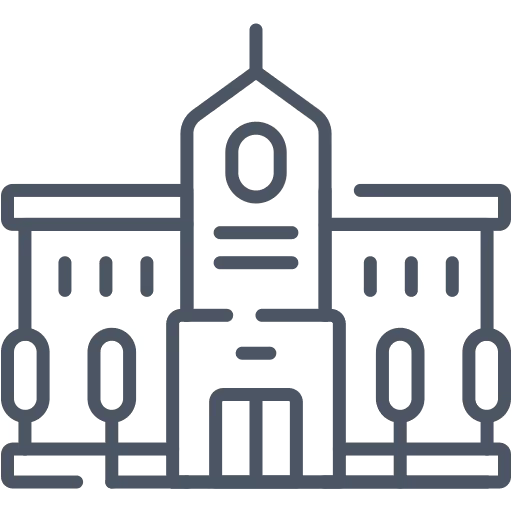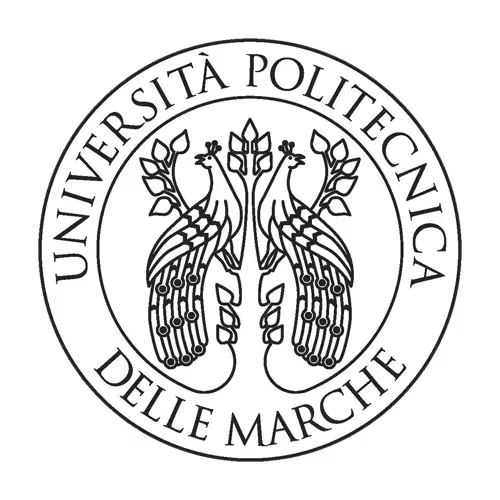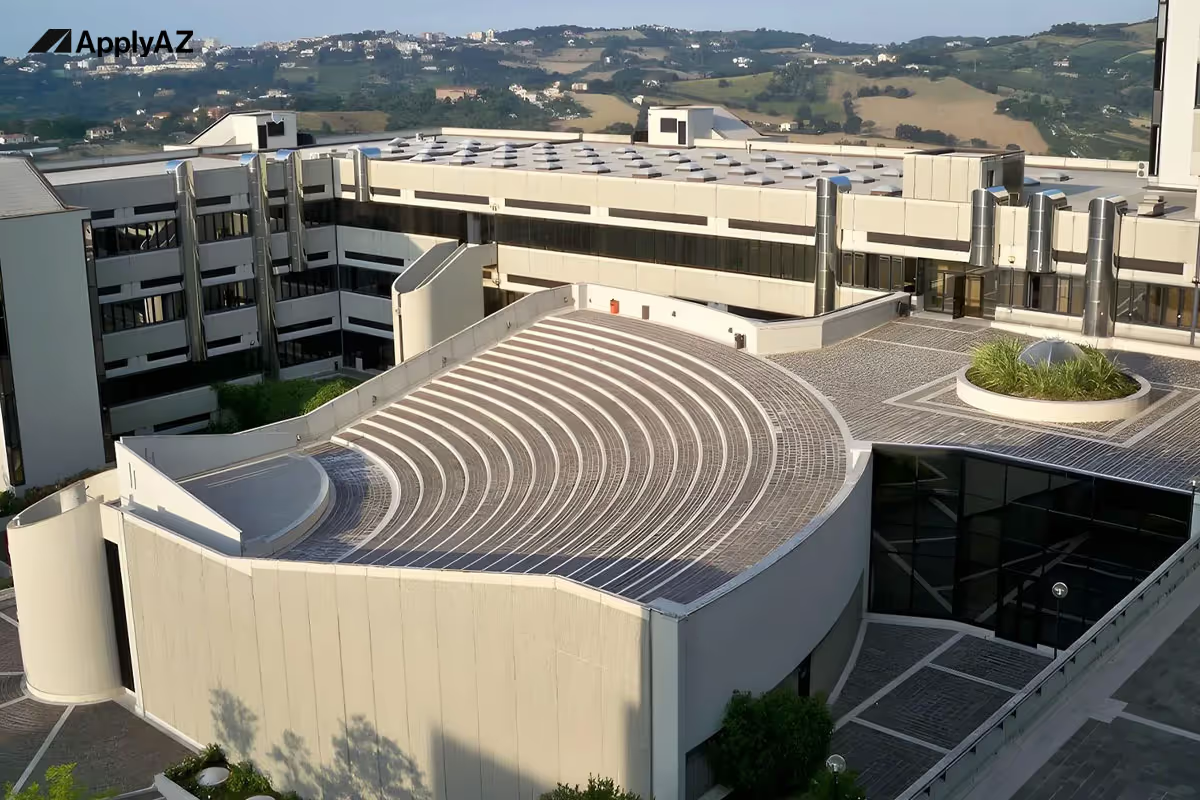Heading
Heading








Study in Italy in English at the Polytechnic University of Marche (Università Politecnica delle Marche)
Discover the Polytechnic University of Marche in Ancona: English-taught programs in Italy, tuition-free options, city life, and career prospects with ApplyAZ.
1. First Glance: Why This University and City Work for You
English-taught programs in Italy let you learn in a world-class setting while enjoying Mediterranean life. The Polytechnic University of Marche (Università Politecnica delle Marche) offers strong Engineering, Life-Science, and Economics degrees that you can study in Italy in English without breaking your budget. Founded in 1969, it has grown into one of the dynamic public Italian universities serving central and Adriatic Europe. Its five faculties sit in coastal Ancona, a safe port city where living costs stay lower than in Milan, Rome, or Florence—ideal for students targeting tuition-free universities Italy.
The campus count is 17,000 students, including 2,200 internationals from more than 90 countries. Class sizes remain small—often 25–40 students—so professors know your name and supervise lab work closely. Labs focus on blue-economy research, renewable energy, and food science, matching the region’s industries. With ApplyAZ handling paperwork and DSU grant forms, you can focus on projects, not bureaucracy.
2. University Overview: Tradition Meets Innovation
2.1 History and Ranking
Although young compared with mediaeval universities, the Polytechnic University of Marche ranks consistently among the top 20 public Italian universities in national surveys. It appears in the world’s top 300 for Marine Engineering and the top 400 for Agricultural Sciences in recent global tables. Its research impact index exceeds Italy’s average by 25 percent, with particular strength in biomedical devices and sustainable manufacturing.
2.2 Key Faculties and Research Centres
- Engineering: Civil, Mechanical, Biomedical, and Computer Engineering share a new Innovation Hub with rapid-prototyping machines and a 5G test zone.
- Science: Biology, Chemistry, and Marine Sciences run joint projects on Adriatic biodiversity and green chemistry.
- Medicine and Surgery: A teaching hospital partners with Ancona’s regional health authority for clinical trials and digital-health trials.
- Agriculture: Offers courses in Food Technology and Agronomy, studying organic farming along the Marche hills.
- Economics: Focuses on maritime logistics, entrepreneurship, and data analytics, preparing students for regional SME networks.
The university belongs to ENLIGHT, a European University Alliance that supports joint degrees, exchanges, and double diplomas. It also runs Erasmus agreements with 360 partners, letting you spend a semester in Berlin, Helsinki, or Valencia without extra fees.
3. Ancona: Life beside the Adriatic
3.1 Student-Friendly Costs
Ancona counts just over 100,000 residents, so everything is walkable. Shared flats cost €220–€320 a month, and student cafeterias serve a three-course lunch for €4. A monthly bus pass is €24; a yearly regional train card covering study commutes costs €50. These prices help the city rank among the most affordable hubs for tuition-free universities Italy.
3.2 Climate and Outdoor Living
The city enjoys hot summers (average 28 °C) and mild winters (around 7 °C). From April to October, you can swim at Passetto Beach or hike Monte Conero’s cliff paths. Winter sees fewer tourists, so you have cafés and museums to yourself while you write essays over espresso.
3.3 Culture and Community
Ancona blends Roman arches, baroque churches, and modern street art. Festivals include:
- Tipicità (March) – showcasing regional food design and agritech start-ups.
- KUM! (October) – a dialogue on psychology and culture led by Nobel scholars.
- Adriatico Mediterraneo (summer) – concerts and theatre on the harbour piers.
International students join free Italian language tandems and theatre workshops held at the Mole Vanvitelliana, a former leper hospital now turned arts centre.
4. Career Paths: Internships and Industry Links in Ancona
4.1 Regional Economic Strengths
- Maritime and Shipbuilding – Fincantieri, one of Europe’s largest shipyards, builds cruise ships and military vessels near the port.
- Agro-Food and Wine – Companies like Fileni and Vini Umani Ronchi export organic chicken and Verdicchio wine worldwide.
- Medical Devices – LivaNova and Sorin Group produce heart-surgery equipment in nearby sites.
- Advanced Mechanics and Robotics – Angelini Technologies and Ariston develop boilers, automation, and smart-home systems.
- ICT and AI – A growing cluster of software start-ups occupies the Baraccola Technology Park.
4.2 University Partnerships
The Polytechnic University of Marche’s Career Service signs about 1,400 internship agreements yearly. Typical placements run 200 hours and earn academic credit. Recent projects include:
- Designing a wave-energy simulator for a renewable-power spin-off.
- Building a VR training tool for harbour crane operators.
- Developing a brand-story campaign for a family wine estate.
Many roles turn into part-time contracts, allowing students to work up to 20 hours a week and earn €650–€800 monthly. Graduates may then use Italy’s 12-month “job-search visa” to finalise a full-time position.
5. Costs, Scholarships, and Tuition Rules
5.1 Fee Structure
Like other public Italian universities, tuition depends on family income. If your household income is below €24,000, annual fees drop to zero. Above that level, fees rise gradually but hardly ever exceed €2,200 per year. Payment happens in two instalments.
5.2 Funding Routes
- DSU grant – a regional scholarship that covers accommodation, meals, and a €2,000 stipend. Awards go to about 4,500 students each year.
- Invest Your Talent in Italy – sponsors master’s-level engineering students, combining fee waivers and company internships.
- Research Assistant Bursaries – supervisor-funded mini-contracts in labs, value €2,500 per semester.
- Merit Awards – €1,000 for top 5 percent of each cohort, renewed yearly.
6. Academic Life: Teaching Style and Support Systems
6.1 Learning Model
Semesters last 12–14 weeks followed by four-week exam sessions. Lectures mix with hands-on labs and field trips to fish farms, wind-turbine sites, or local SMEs. Professors encourage project-based learning: you write papers, code prototypes, or harvest sensor data rather than memorise notes for rote exams.
6.2 Language Path
Freshers attend free Italian classes until they reach B1 level. This skill helps them integrate with clubs and part-time jobs. Scientific terminology remains in English, so performance during assessments does not depend on Italian fluency.
6.3 Student Services
- Buddy Scheme – senior students greet newcomers at Ancona station, help with housing paperwork, and run city tours.
- Counselling Centre – English-speaking psychologists offer confidential sessions.
- Disability Office – arranges assistive tech and extra time during exams.
- Entrepreneurship Lab – hosts start-up weekends, giving seed grants of €3,000 to winning teams.
7. Research Highlights: Solving Real-World Problems
- Blue Rise Project – Converts sea-wave motion into power, aiming to supply 15 percent of regional electricity by 2030.
- Smart Barns Initiative – Uses IoT sensors to cut livestock methane by 18 percent; trials run on university farms.
- Molecolare 3D – A bio-printing centre that produces tissue scaffolds for reconstructive surgery.
- Circular Port Logistics – Optimises container flow to reduce berth waiting times by 22 percent, saving fuel and cutting CO₂.
Students can join these teams as thesis researchers, gaining citations before graduation.
8. Living Well: Housing, Food, and Free Time
8.1 Housing Choices
- DSU Residences – twin rooms, shared kitchens, Wi-Fi, gym; cost €0–€280/month depending on grant status.
- Private Shared Flats – common in Capodimonte and Adriatico quarters, 10-minute bus ride from campus.
- Host Families – good for language immersion; about €350 including breakfast and dinner.
8.2 Eating Out
Daily menus in the Mensa (canteen) feature pasta, grilled fish, and seasonal vegetables. Prices stay €2–€4 per course. Weekly farmers’ markets sell strawberries, olives, and pecorino cheese for less than supermarkets. Street food highlights include stuffed olive ascolane and fried cremini custard cubes.
8.3 Weekend Ideas
- Ferry to Split or Zadar, Croatia, from Ancona port in 11 hours.
- Ski in the Apennine resort of Sarnano (90 minutes by car) from December to March.
- Join Erasmus networks for wine-tasting tours in Jesi’s Verdicchio cellars.
With low travel costs, you can explore Europe while keeping Ancona as a calm study base.
In two minutes we’ll confirm whether you meet the basic entry rules for tuition-free, English-taught degrees in Italy. We’ll then quickly see if we still have space for you this month. If so, you’ll get a personalised offer. Accept it, and our experts hand-craft a shortlist of majors that fit your grades, goals, and career plans. Upload your documents once; we submit every university and scholarship application, line up multiple admission letters, and guide you through the visa process—backed by our admission-and-scholarship guarantee.
Biomedical Engineering (LM-21) at Marche Polytechnic University
Biomedical Engineering (LM-21) at Marche Polytechnic University (Università Politecnica delle Marche) offers a structured way to study in Italy in English inside a reliable system of public Italian universities. It belongs to English-taught programs in Italy that connect engineering with medicine and data. With the DSU grant and scholarships for international students in Italy, many candidates reduce costs and get closer to options mentioned as tuition-free universities Italy.
English-taught programs in Italy: where LM-21 fits and what you will study
LM-21 is the national master’s class for Biomedical Engineering. It follows a two-year, 120 ECTS plan (European Credit Transfer and Accumulation System). Teaching blends lectures, labs, design studios, seminars, and a research thesis. You will move from fundamentals to focused areas and build a portfolio that shows clear, testable results.
Core scientific foundations
- Human physiology for engineers: systems view of the body; signals, flows, and feedback.
- Signals and systems: time/frequency analysis, filters, sampling, and noise.
- Probability and statistics: estimation, testing, confidence intervals, and power.
- Numerical methods: optimisation and simulation for biomedical problems.
- Ethics and regulation: safety, privacy, device classification, and standards.
Biomedical technology pillars
- Biomedical instrumentation: sensors (ECG, EEG, EMG), amplifiers, and safety.
- Medical imaging: X-ray/CT, MRI, ultrasound; reconstruction and image quality.
- Biomaterials: metals, polymers, ceramics, and composites for implants; biocompatibility.
- Biomechanics: solids and fluids; gait, tissue mechanics, and prosthetic design.
- Rehabilitation engineering: assistive devices and human–machine interfaces.
- Bioinformatics: sequence data, omics (large biological datasets), and pipelines.
- eHealth and digital health: data models, interoperability, and privacy rules.
- AI for health (intro): careful use of machine learning in clinical contexts.
How learning becomes evidence
- Lab notebooks with raw and processed data kept separate.
- One main figure per claim (axes, units, sample size clear).
- A short “limits and next steps” note after each experiment.
- Executive summaries in plain English for non-engineer readers.
Study rhythm that works
- Weekly targets: one concept, one problem set, one clean figure.
- Read one paper; write five lines on methods, limits, and value.
- Keep English active by writing 300–500 words twice a week.
Study in Italy in English: skills, labs, and a portfolio you can show
This master’s is designed for practical impact. You will train in labs, write short memos in English, and deliver results that managers and clinicians can use. Your portfolio will prove not only what you know but also how you work.
Laboratory and studio learning
- Biosignals lab: acquisition, filtering, feature extraction; report accuracy and latency.
- Imaging workshop: segmentation, registration (aligning images), quality metrics.
- Biomechanics studio: motion capture, inverse dynamics, and prosthetic tuning.
- Instrumentation build: sensor selection, circuit safety, calibration, and validation.
- Data clinic: anonymisation, audit trails (who accessed data), model tracking.
- Regulatory clinic: device risk class, essential requirements, and test plans.
Reporting habits that build trust
- Begin every report with the decision it supports.
- State data sources and inclusion rules.
- Give confidence intervals, not just point values.
- Label all axes and time windows; include units.
- End with a practical next step (test, limit, or rollout rule).
Project examples (illustrative)
- Wearable ECG: low-power design, motion artefact rejection, and alarm logic.
- Ultrasound speckle reduction: balance between smoothing and detail retention.
- ACL rehab tool: sensor-based knee angle tracking; feedback latency under 100 ms.
- CT dose review: dose index vs image quality; protocol decision memo.
- Sepsis alert (ward data): calibration, false alarms, and clinician workflow fit.
- Spinal implant surface: roughness and coating to aid osseointegration (bone bonding).
Communication in English that travels
- One idea per slide; large, readable charts.
- Two sentences per figure: what it shows and why it matters.
- If challenged, restate the claim and point to data.
- Offer a guardrail when uncertainty is high (e.g., “alert only if repeated twice”).
A four-semester path (illustrative)
- Semester 1: Physiology, Signals, Statistics, and Biomedical Instrumentation I.
Portfolio piece: sensor calibration report with uncertainty. - Semester 2: Imaging, Biomechanics, Biomaterials, and Regulation.
Portfolio piece: imaging metric study with a clear trade-off. - Semester 3: Digital Health, AI basics, and Research Methods.
Portfolio piece: model card (purpose, data, limits) and a deployment note. - Semester 4: Thesis and defence in English.
Portfolio piece: abstract, two key figures, and a tidy readme for data/code.
Public Italian universities: structure, assessment, and career routes
As part of public Italian universities, this degree follows a transparent structure. Calendars, exam windows, and resits are published early. You can plan labs, internships, and your thesis without clashes. The ECTS framework helps employers and doctoral schools compare training across Europe.
Assessment you can prepare for
- Written exams: principles, methods, and short calculations.
- Oral exams: clarity under questions and careful definitions.
- Lab artefacts: notebooks, code, and data with audit trails.
- Design reviews: device feasibility and safety logic.
- Thesis defence: evidence first, then interpretation.
Graduate skill profile
- Rigorous method and clean documentation.
- Respect for safety, privacy, and standards.
- English communication that helps teams act.
- Calm delivery under pressure and review.
Careers across health and technology
- Medical device design and R&D: sensors, implants, and diagnostics.
- Imaging and radiology support: protocol design and quality assurance.
- Digital health and hospital engineering: interoperable systems and data safety.
- Rehabilitation and assistive tech: orthotics, prosthetics, and interfaces.
- Clinical engineering services: equipment planning, testing, and maintenance.
- Regulatory affairs and quality: documentation, audits, and compliance.
- Data-centric roles: biostatistics, clinical analytics, and AI validation.
- Research and PhD: biomechanics, biomaterials, imaging, or informatics.
What employers value
- Decision-ready figures with units and ranges.
- Reproducible code and tidy files.
- Honest uncertainty and clear next steps.
- Respect for privacy and cyber-security basics.
- On-time delivery and teamwork.
How to build a hiring-ready portfolio by Semester 3
- Instrument dossier: sensor choice, safety, and calibration figure.
- Imaging brief: baseline vs improved method with fair comparison.
- Biomechanics note: model limits and validation with measured data.
- Digital health memo: data map, consent, and rollback plan.
Keep each item to one or two pages with links to code and a short readme.
Admissions: presenting a strong, honest profile
- Statement of purpose (600–800 words): your path and one biomedical question you want to study.
- CV (two pages): modules, tools, and two or three projects with outcomes.
- Transcript and degree certificate: highlight signals, control, materials, statistics, and programming.
- Portfolio sample: one analysis with a labelled figure and limits.
- References: writers who can speak to rigour and teamwork.
If your background is mixed, add a bridging project with a clear method and a strong chart.
Daily habits that protect quality
- Plan on Monday; review on Friday.
- Draft the key figure before you code.
- Name assumptions and check units every time.
- Keep raw and processed data in separate folders.
- Sleep enough; tired minds miss simple errors.
Pathways toward tuition-free universities Italy: DSU grant and scholarships
Studying within public Italian universities means funding rules are published early. With the right documents and timing, many students reduce fees and move closer to tuition-free universities Italy. Plan funding with the same care you plan labs.
Income-based fees
- Tuition often depends on verified family income bands.
- Prepare documents on income and family composition.
- Add translations or legalisations where required.
- Submit early; archive confirmations.
DSU grant
- The DSU grant (regional right-to-study support) can include a fee waiver, meal support, a housing contribution, and sometimes a stipend.
- Eligibility combines income and merit; renewal rules apply in year two.
- Deadlines may be early; gather documents in your home country and follow the exact format.
Scholarships for international students in Italy
- Awards recognise strong grades or themes such as safety, sustainability, or digital health.
- Check if a scholarship can combine with the DSU grant and fee band.
- Keep a calendar of calls and a reusable document kit (scans, translations, verified copies).
- Draft a base statement (150–250 words) and tailor it for each call.
Five simple steps to stay organised
- Map fee-band, DSU grant, and scholarship deadlines for the year.
- Create one labelled folder with all scans and certified copies.
- Apply early; confirm receipt; track outcomes.
- Plan a monthly budget for printing, software, and small lab items.
- Prepare renewal files one month before year two.
Budget habits that reduce stress
- Share print runs and buy consumables in groups.
- Keep a simple spreadsheet for deadlines and results.
- Reuse verified scans when rules allow.
- Set aside a small reserve for unexpected costs.
How funding and study reinforce each other
- Predictable fees and support let you focus on labs.
- Early award results help you lock in housing and equipment.
- Clear budgets support better time management and grades.
Ready for this programme?
If you qualify and we still have a spot this month, we’ll reserve your place with ApplyAZ. Our team will tailor a set of best-fit majors—including this course—and handle every form and deadline for you. One upload, many applications, guaranteed offers, DSU grant support, and visa coaching: that’s the ApplyAZ promise. Start now and secure your spot before this month’s intake fills up.

They Began right where you are










